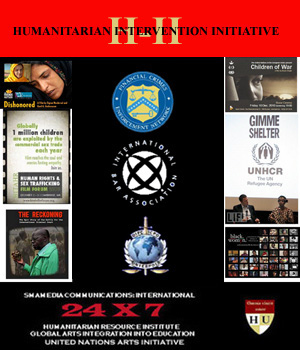20 December 2011 -
Updated 7 April 2014.
Contact:
Stephen M. Apatow
Founder,
Director of Research & Development
Humanitarian
Resource Institute (UN:NGO:DESA)
Humanitarian University
Consortium Graduate Studies
Center
for Medicine, Veterinary Medicine & Law
Phone:
203-668-0282
Email:
s.m.apatow@humanitarian.net
Internet:
www.humanitarian.net
H-II OPSEC
Url: www.H-II.org

H-II
OPSEC -
Expanding Global Intercoordinated Anti-Human Trafficking Operations
The
Anti-Human
Trafficking Manual for Criminal Justice Practitioners is the
result of a global cooperative process in which expert representatives
from academia, NGOs, international organizations, law enforcement
officers, prosecutors and judges from all over the world contributed
their expertise and experiences.
In
line with the Trafficking in Persons Protocol supplementing the United
Nations Organized Crime Convention, the purpose of the Anti-Human
Trafficking Manual for Criminal Justice Practitioners is to
support criminal justice practitioners in the prevention of human
trafficking, the protection of its victims, the prosecution of its
culprits and in the international cooperation needed to achieve these
goals.
The
Anti-Human Trafficking Manual for Criminal justice practitioners is
available in Arabic,
Chinese,
English,
French,
Russian
and Spanish
Training Modules
Include:
- Module 1: Definition of trafficking in persons
and smuggling of migrants
- Module 2: Indicators of trafficking in persons
- Module 3: Psychological reaction of victims of
trafficking in persons
- Module 4: Control methods in trafficking in
persons
- Module 5: Risk assessment in trafficking in
persons investigations
- Module 6: International cooperation in
trafficking in persons cases
- Module 7: Crime scene and physical evidence
examinations in trafficking in persons investigations
- Module 8: Interviewing victims of trafficking
in persons who are potential witnesses
- Module 9: Interviewing child victims of
trafficking in persons
- Module 10: Interpreters in trafficking in
persons investigations
- Module 11: Victims' needs in criminal justice
proceedings in trafficking in persons cases
- Module 12: Protections and assistance to
victims-witnesses in trafficking in persons cases
- Module 13: Compensation for victims of
trafficking in persons
- Module 14: Considerations in sentencing in
trafficking in persons cases
Trafficking
in Humans Report 2011
The U.S. Department of
State Trafficking
in Persons Report 2011 includes more than
180 narratives
that assess governments on their efforts to combat trafficking in
persons. In keeping with the language and values of the UN Trafficking
Protocol, which seek to guarantee prevention, prosecution, and
protection for the maximum number of victims, the United States defines
trafficking in persons to include all of the conduct involved in forced
labor as well as the trafficking of adults and children for commercial
sexual exploitation.
Download
the Trafficking
in Humans Report 2011: U.S. Department of
State: Office To Monitor
and Combat Trafficking in Persons. Available in Arabic | Chinese | French | Persian | Russian | Spanish.
Related:
###